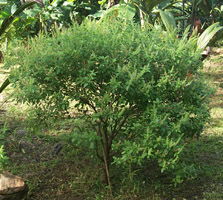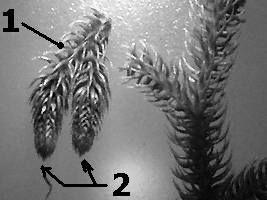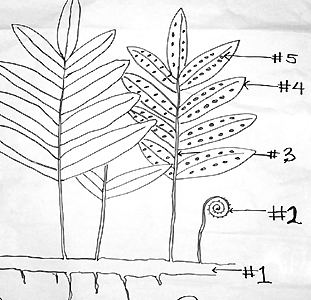- The sample of green slime from the swamp across the road had the following appearance:

This was also the first sample we examined under the microscope. This is an example of
(circle the letter of the correct answer:
- Archaebacteria
- Cyanobacteria
- Filamentous green algae
- Green eggs in a tube
- Which of the following is the correct Latin binomial (scientific name) for the Hindi
plant "chotachand," the plant that led to the development of modern high blood
pressure medicine?
- Ravolfia
- serpentina
- Ravolfia serpentina
- Apocynaceae Ravolfia serpentina
- Give one reason ethnobotanists tend to study indigenous peoples.
- In class Dana presented information on the plant seen on the right, known as aring,
kadiring, or waring, among other local names. In what location on the planet is the
origin for this plant (where is it from originally)?

- Africa
- India
- Pohnpei
- Samoa
- What is the name of the plant seen on the right in English?
- Holy basil
- Holy ghost
- Holy water
- Sacred herb
- What is the Latin binomial for the plant seen on the right?
- Ocimum sanctum
- Clerodendrum inerme
- Piper nigrum
- Ohsaycanusee sanctuary
- What illness was Dana treating himself for with the plant shown?
- diarhea
- ghost sickness
- head cold
- insanity
- What is the local name for the healing plant shown in your language?
- What is the function of the heterocyst in cyanophyta (Nostoc, Anabaena)?
- Label the parts numbered one and two in the following image of Lycopodiella cerna:

- Label the parts numbered one to five in the following sketch:

- Explain the meaning of the term "famine foods."
- Explain briefly, from an ethnobotanical viewpoint, the absence of diabetes on Pohnpei in
1945 and the widespread presence of diabetes now.
- We all know that local food is good for us. Take a moment and think carefully.
Then list the foods you had for dinner the last three nights.
- Write a paragraph comparing and contrasting the use of plants by hunter gatherer
societies and agarian societies.
- Draw a sketch of Asplenium nidus.


